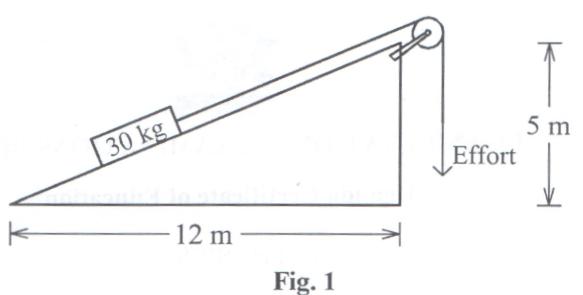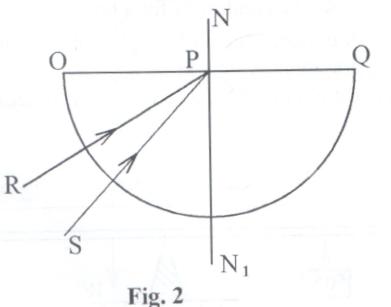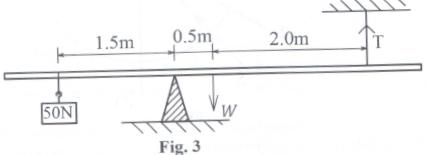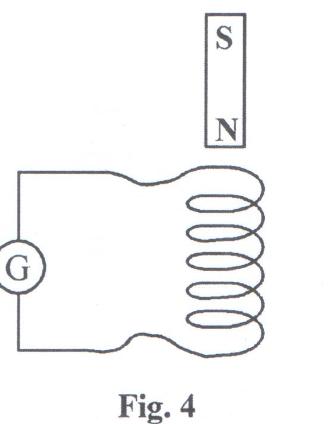1. a) What is meant by the following as applied to machines?
i) Velocity ratio
ii) Efficiency
b) Figure 1 shows a mass of 30kg being raised to the top of the incline.

If the effort applied is 160 N, calculate the
i) efficiency of the machine
ii) frictional force
c) i) Define static friction.
ii) Describe an experiment to determine static friction between a wooden block and a table.
iii) State two advantages of friction.
2. a) State Charles’ law
b) Describe an experiment to verify Charles’ law.
c) When 80cm3 of air at 100kPa and at a temperature of 70C is compressed to 38cm3, its temperature rises to 280C.
What is the pressure of the compressed air?
d) Using simple kinetic theory, explain why there is no increase in temperature of boiling water even when more heat is supplied to the water.
e) i) What is meant by saturated vapor?
ii) Explain why food in a covered saucepan takes a shorter time to cook.
3. a) State any three differences between cathode rays and X-rays
b) i) Draw a labeled diagram showing the main parts of a cathode ray oscilloscope.
ii) State any two uses of cathode ray oscilloscope
c) i) Describe energy changes that take place in an X-ray tube from the point of production of electrons to the cathode.
ii) Explain how the strength of the X- rays produced can be increased.
d) What is meant by
i) Radioactivity?
ii) Nuclear fission?
4. a) i) What is meant by refractive index of a given medium?
ii) Define critical angle.
iii) State the conditions for total internal reflection to occur.
b) Figure 2 shows rays of light incident on semi-circular glass block. Ray SP is refracted along PQ

Explain
i) why rays RP and SP are not refracted at the points of incidence on the glass block.
ii) With the aid of the diagram what happens to ray RP
c) With the aid of a labeled diagram, explain why a pond with clear water appears shallower than it actually is.
d) Calculate the critical angle for a glass of refractive index 1.50
5. a) i) State the law of electrostatics
ii) Explain how the nature of charge on a body may be determined using a gold leaf electroscope.
b) Explain why power cables for cookers are thicker than the ones for lighting.
c) i) Explain why voltage is first stepped up before transmission.
ii) What are the disadvantages of transmission at high voltages?
d) i) State three ways in which power is lost in a transformer.
ii) Five equal electric bulbs are switched on for 8h a day for thirty days. If each unit costs Shs600 and the total monthly bill is Shs43,200. Find the power rating of each bulb.
6. a) i) What is meant by centre of gravity of a body?
ii) Given a uniform meter rule, a known mass M0, a knife edge and a piece of thread, describe how the mass of the meter rule can be determined.
b) i) State the conditions for a body to be in equilibrium.
ii) A uniform beam of weight 500 N is made to balance horizontally on a knife edge by a string tied near one end and a weight of 50 N hanged near the other end as shown in figure 3.

If W is the weight of the beam, find the tension in the string and the reaction of the knife-edge on the beam.
c) i) State the law of floatation
ii) A solid of volume 10-5m3 floats in water of density 103 kgm-3 with four – fifths of its volume submerged. Find the mass of the solid.
d) State one application of the law of floatation.
7. a) i) What is meant by resonance as applied to sound?
ii) Howa re stationary waves formed?
iii) Describe an experiment to demonstrate resonance in sound
b) i) Sketch the standing wave in a closed tube corresponding to the fundamental note
ii) If the frequency of the fundamental note in (b) (i) is 110Hz, find the length of the air column in the tube. (Take speed of sound = 330ms-1)
c) i) What are electromagnetic waves?
ii) Infrared radiation and ultraviolet radiation are both electromagnetic State one common property and one difference between infrared radiation and ultraviolet radiation.
d) Why are radio signals clearer at night than during day?
8. a) What is electromagnetic induction?
b) State the factors that determine the magnitude of the induced e.m.f in electromagnetic induction.
c) A small bar magnet is released from above a long coil of many turns connected to a centre-zero galvanometer as shown in figure 4

Describe what will be observed on the galvanometer as the magnet falls through the coil.
d) With the aid of a labeled diagram describe how the electric bell works.
e) Why is soft iron used in electromagnets instead of steel?
